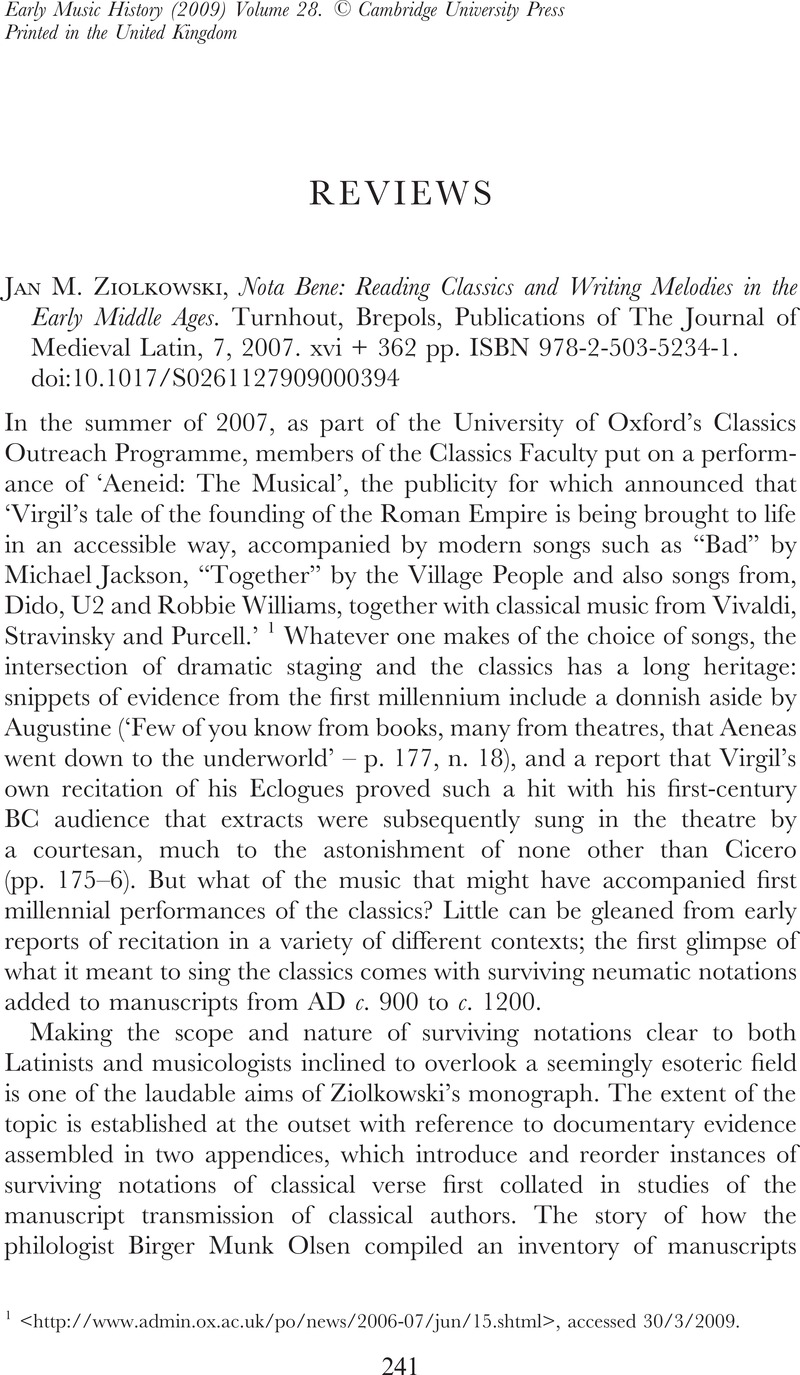No CrossRef data available.
Article contents
Anna Maria Busse Berger, Medieval Music and the Art of Memory. Berkeley: University of California Press, 2005. xvi + 288 pp. ISBN 0-520-24028-6.
Published online by Cambridge University Press: 24 August 2009
Abstract

- Type
- Reviews
- Information
- Copyright
- Copyright © Cambridge University Press 2009
References
1 For a more balanced critical view of Ludwig's legacy, see J. Haines, ‘Friedrich Ludwig's “Musicology of the Future”: A Commentary and Translation’, Plainsong and Medieval Music, 12 (2003), pp. 129–64.
2 M. Carruthers, The Book of Memory: A Study of Memory in Medieval Culture (1990; 2nd edn, Cambridge, 2008); The Craft of Thought: Meditation, Rhetoric, and the Meaning of Images, 400–1200 (Cambridge University Press, 1998).
3 M. Huglo, Les tonaires: inventaire, analyse, comparaison (Paris, 1971), summarised in New Grove Dictionary online (accessed Apr. 2009).
4 R. Burton, Classical Poets in the ‘Florilegium Gallicum’ (Frankfurt am Main, 1983).
5 See, for example, the treatise of c. 1100, Johannes, De musica cum tonario, ed. J. Smits van Waesberghe (Corpus Scriptorum de Musica, 1; Rome, 1950), p. 50: ‘In manus etiam articulis modulari sedulus assuescat, ut ea postmodum quotiens voluerit pro monochordo potiatur et in ea cantum probet, corrigat et componat’ (‘Indeed, one should avidly practice playing upon the joints of one's hand, so that after a while, whenever one wishes, one may become accomplished in using it instead of a monochord, and may test, correct and compose chant on it’).
6 J. Bermudo, El libro llamado declaración de instrumentos musicales (Osuna, 1555), bk. 5, ch. 11, fol. 126.
7 She reports the late (1450) ‘joint’ appointment of Arnoul Greban to the positions ‘magister grammaticae’ and ‘magister puerorum chori’ as if it were unusual rather than absolutely typical, and does not cite the literature that discusses the ways in which music treatises were modelled on, and borrowed terminology from, grammar treatises; see C. Bower, ‘The Grammatical Model of Musical Understanding in the Middle Ages’, in P. Gallacher and H. Damico (eds.), Hermenutics and Medieval Culture (Albany, NY, 1989), pp. 133–45; K. Desmond, ‘Sicut in grammatica: Analogical Discourse in Chapter 15 of Guido's Micrologus’, Journal of Musicology, 16 (1998), pp. 467–93, and W. Flynn, Medieval Music as Medieval Exegesis (Lanham, Md., 1998), pp. 9–106.
8 S. Immel, ‘The Vatican Organum Treatise Re-Examined’, Early Music History, 20 (2001), pp. 121–72.
9 In ch. 5 Busse Berger provides a similar explanation of the far less problematic notational ambiguities of the Notre Dame repertory itself.
10 ‘Quare prima regula debet esse ista: omnis volens componere faciat processum huiusmodi in omni discantu sic ut plures ponat clausulas secundum formam prenotatam.’ Anonymus, Tractatus de cantu figurativo et de contrapuncto (c. 1430–1520), ed. C. Meyer (Corpus Scriptorum de Musica, 41; Neuhausen-Stuttgart, 1997), p. 105. Meyer dates the MS c. 1510–20.
11 See The Winchester Troper, facs. ed. S. Rankin (Early English Church Music, 50; London, 2007).
12 M. Fassler, ‘The Office of the Cantor in Early Western Monastic Rules and Customaries: A Preliminary Investigation’, Early Music History, 5 (1985), pp. 29–51.
13 See also N. Phillips and M. Huglo, ‘Le De musica de saint Augustin et l'organisation de la durée musicale du IXe au XIIe siècles’, Recherches augustiniennes, 20 (1985), pp. 117–31.
14 M. Fassler, ‘Accent, Meter, and Rhythm in Medieval Treatises “De Rithmi”’, Journal of Musicology, 5 (1987), pp. 164–90.
15 Guillaume Gross demonstrated the significant connections between the creation of such flores and the educational context of the trivium at Notre Dame in his dissertation of 2004, revised for publication as Chanter en polyphonie à Notre-Dame de Paris aux 12e et 13e siècles (Turnhout, 2008) and summarised in ‘Organum at Notre-Dame in the Twelfth and Thirteenth Centuries: Rhetoric in Words and Music’, Plainsong and Medieval Music, 15 (2006), pp. 87–108.
16 See J. Flynn, ‘Tudor Organ Versets: Echoes of an Improvised Tradition’, Journal of the Royal College of Organists, 3 (2009), pp. 6–26.




